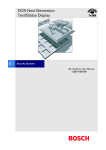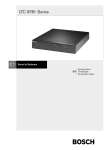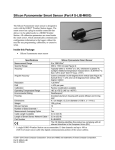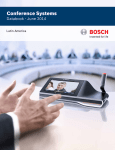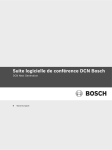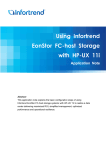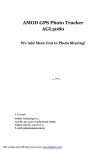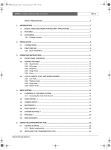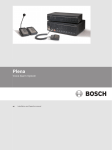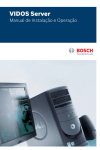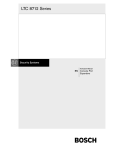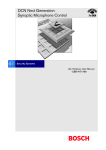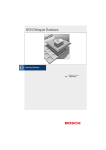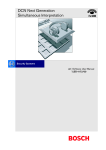Download DCN Next Generation System Installation
Transcript
DCN Next Generation System Installation en Software User Manual LBB 4185/00 About this manual This user manual is divided into three chapters. Chapters 1 and 2 provide background information and chapters 3 provides detailed user information as follows: • Chapter 1 - System Installation - containing a brief overview of the Digital Congress Network Next Generation, a summary of the application modules available and an overview of the functionality of the System Installation application. • Chapter 2 - Getting Started - containing details of how to start the System Installation application from the Startup screen and a description of the Help facility. • Chapter 3 - Using System Installation containing details about assigning and working with seat numbers, configuring channels, printing, working with installation files, and how to exit System Installation. Manual conventions For clarity this user manual uses consistent styles, symbols and typographical conventions. They are: i Note General notes are contained within rules and indicated with this symbol at the left margin. Notes are used to draw attention to special actions or information. i Caution A caution is contained within rules and indicated with this symbol at the left margin. Cautions are used to draw attention to actions or commands that could lead to a loss of information or damage to equipment i Tip A tip is contained within a box and indicated with this symbol at the left margin. Tips are used to provide supplementary information that may make an action quicker or easier to carry out. • An action (to be carried out by the user) is shown with a larger round bullet mark. Typographical conventions The following typographical conventions (text styles) are used in this manual: • Typed input - information to be typed in using the keyboard is shown as: Filename • Single key - input via a single key (or keys) on the keyboard is shown as: <enter>, <shift>, etc. • Multiple keys - input via a combination of keys pressed together is shown as: <ctrl>+<p>, <alt>+<f4> • Screen text - information that appears on screen is shown as: ‘Choose Startup Modules:’ Hyperlinks This manual is also available as a digital document in the Adobe Portable Document Format (PDF). All references to pages, figures, tables, etc. in this digital document contain hyperlinks to the referenced location. DCN Next Generation System Installation Table of contents 1 1.1 1.1.1 2 2.1 2.1.1 2.2 2.2.1 2.2.2 2.2.3 2.2.4 2.2.5 2.2.6 2.2.7 2.2.8 3 3.1 3.2 3.2.1 3.3 3.3.1 3.3.2 3.3.3 3.4 3.5 3.6 3.7 3.8 System Installation ................................................... 4 About system installation....................................... 4 What is System Installation? ................................ 4 Getting Started............................................................ 5 Starting System Installation .................................. 5 The Startup screen ................................................. 5 Selecting an installation (and a names) file...... 5 The System Installation icon ................................ 5 Using Help ................................................................ 5 The Help menu......................................................... 5 Index ........................................................................... 5 Keyboard ................................................................... 6 Commands ............................................................... 6 Procedures ............................................................... 6 Glossary .................................................................... 6 Using Help ................................................................ 6 About.......................................................................... 7 Using System Installation ..................................... 8 The system installation main windows ............... 8 Assignment seat numbers..................................... 8 Accessing install mode.......................................... 8 Resetting the ‘Installed’ list .................................. 9 Assigning seat numbers to numberless units.. 9 Changing newly-assigned seat numbers........10 Inserting new seat numbers...............................10 Deleting an item on the ‘Installed’ list..............10 Changing the seat numbers of alreadyassigned units .......................................................11 Configuring channels and external contact ....11 Channel assignment.............................................11 External Contact ....................................................12 No Function ...........................................................12 Present....................................................................12 Fraud........................................................................12 Testing channels ...................................................12 Accessing System Configuration information 13 Downloading font sets .........................................13 Working with installation files.............................13 Creating a new installation file...........................14 Opening an existing installation file..................14 Saving an installation file.....................................14 Saving an installation file under a new name .14 Deleting an installation file..................................15 Printing.....................................................................15 Exiting system installation....................................16 Temporarily exiting System Installation............16 Permanently exiting System Installation ..........16 Bosch Security Systems B.V. | 2005 January | 9922 141 70462 en | 3 DCN Next Generation System Installation 1 System Installation 1.1 About system installation 1.1.1 What is System Installation? The System Installation software module is one of a family of modules designed for controlling and monitoring conferences and discussions using the contribution equipment. The System Installation program registers the physical presence of microphones and delegate units in a conference hall and supply this information to the system. This information is vital for certain other modules, e.g. Synoptic Microphone Control. Without the installation information these modules cannot function properly. System Installation is basically a preparation program. Once all contribution units have been initialized from the system (for more information, refer to the DCN Next Generation Installation and User Instructions) and assigned seat numbers, and the audio channels configured and tested, there will be no need to use System Installation for day-to-day monitoring and controlling of a conference. However, if the physical layout changes in the conference hall (delegate units are removed or added, for example) then the data in System Installation must be updated. System Installation offers the following possibilities: • Assigning seat numbers to units without numbers. • Changing already-assigned seat numbers. • Configuring the audio channels. • Configuring the external contact. • Opening, closing, saving, editing and deleting installation files. • Sending test signals down the audio channels. • Printing information concerning System Installation. Bosch Security Systems B.V. | 2005 January | 9922 141 70462 en | 4 DCN Next Generation System Installation 2 Getting Started 2.1 Starting System Installation 2.1.1 The Startup screen The System Installation program is started from the Startup screen (shown below). en | 5 modules will not run without the appropriate installation or names file. You can specify an installation file from the Startup main window, or from the System Installation program. If an installation file has been specified from Startup, it is still possible to work on other installation files once in System Installation. System Installation does not make use of the information in the names file. i Note If system installation is in install mode, all conference activities are suspended (refer to paragraph 3.2.1). Selecting an installation (and a names) file For details on selecting an installation (and a names) file, please refer to the Startup user manual (LBB 4190). The System Installation icon For details on the System Installation icon and how to start System Installation from Startup, please refer to the Startup user manual (LBB 4190). Figure 1 The Startup screen. i Note For starting the Startup program from an icon in the desktop, refer to the Startup user manual. The software uses two user-created files that contain important information about the installed hardware configuration and about delegates’ names. These files are: • Installation file - containing information about channel assignment and the numbers that have been assigned to all microphones connected to thesystem. These seat numbers are assigned using this software module. • Names file - containing information about the name, seat number and other conference and personal details of participating delegates. Names files are created using the Delegate Database software (LBB 4180). The software modules may be started up from the Startup main window without specifying either an installation or names file. However, some software 2.2 Using Help 2.2.1 The Help menu The ‘Help’ menu in the title bar contains commands for an on-screen help facility. This help facility contains information on all commands in the ‘File’ menu, on which keyboard keys are functional, a description of how to use the software, information on how to use the help facility itself, plus an index and a glossary of terms. All information contained in this user manual is also found in the ‘Help’ facility. The ‘Help’ facility contains the following options: • Index • Keyboard • Commands • Procedures • Glossary • Using Help • About System Installation. 2.2.2 Index To access the index: Bosch Security Systems B.V. | 2005 January | 9922 141 70462 • Select the ‘Help’ menu and click on ‘Index’. DCN Next Generation System Installation A full list of subjects covered by the help facility is given in alphabetical order. For more information on any subject contained in the index: • en | 6 • An on-screen page with the requested information will appear. Click on the required subject in the index. An on-screen page with the requested information will appear. 2.2.6 Glossary To access the glossary: • 2.2.3 Keyboard This gives information on which keys on your keyboard can be used with the software. This includes using keys to activate menu items, to move around in dialogue boxes, for short cuts, and to select options from the main window. To access the ‘Keyboard’ help facility: • Select the ‘Help’ menu and click on ‘Keyboard’. A list of different key types is given. For more information on any key type contained in the list: • 2.2.4 Commands This gives information on all menu options, covering the ‘File’, ‘Edit’, ‘View’, ‘Settings’ and ‘Help’ menus. To access the ‘Commands’ help facility: Select the ‘Help’ menu and click on ‘Commands’. A list of menu groups is given. For more information on any menu group contained in the list: • • 2.2.7 Using Help This gives information on how to use the help facility. To access the ‘Using Help’ facility: • • Click on the required topic in the list. A list of options for the selected topic is given. For more information on any option contained in the list: • Click on the required option in the list. An on-screen page with the requested information will appear. Click on the required menu group in the list. Click on the required option in the list. 2.2.5 Procedures This gives information on how to use the software. To access the ‘Procedures’ help facility: Select the ‘Help’ menu and click on ‘Procedures’. A list of topics is given. For more information on any topic contained in the list: • Select the ‘Help’ menu and click on ‘Using Help’. A list of topics is given. For more information on any topic contained in the list: An on-screen page with the requested information will appear. • Click on the required subject in the index. A window with the requested information will appear. A list of options in the selected menu group is given. For more information on any option contained in the list: • Select the ‘Help’ menu and click on ‘Glossary’. A list of terms used in the help facility is given in alphabetical order. For more information on any term contained in the glossary: Click on the required key type in the list. An on-screen page with the requested information will appear. • Click on the required option in the list. Click on the required topic in the list. A list of options for the selected topic is given. For more information on any option contained in the list: Bosch Security Systems B.V. | 2005 January | 9922 141 70462 DCN Next Generation System Installation 2.2.8 About This provides software release information. To display the ‘About...’ window: • Select the ‘Help’ menu and click on ‘About System Installation...’. The following window appears: Figure 2 The ‘About...’ window To remove this window: Click on the ‘OK’ push button. Bosch Security Systems B.V. | 2005 January | 9922 141 70462 en | 7 DCN Next Generation System Installation 3 Using System Installation 3.1 The system installation main windows The System Installation main window is used to assign seat numbers, and to provide access to the other dialogue boxes of the System Installation program. i Note The contribution units cannot be initialized using System Installation. For details of initialization, please refer to the DCN Next Generation Installation and User Instructions. en | 8 The full list of menu options is as follows: File Settings New… Channel Assignment… System Config! Download Font! Open… Help Index… Keyboard Options… Save Commands Save As… Channel Tests… Procedures Delete… Glossary Print… Using Help Exit About… 3.2 Assignment seat numbers From the main window of System Installation you can assign seat numbers to delegate and chairman units. The System Installation software checks for the physical presence of such units, and compiles a list of all units present. The number of units without seat numbers will be displayed in front of the text ‘Unit(s) without Seat Numbers’. If you are working with a new installation file, then all units will be without seat numbers. i Note It is also possible to manually assign and change contribution unit seat numbers by means of the microphone button on the units. Figure 3 The System Installation main window. In the title bar at the top of this window, the installation file name is displayed. If an installation file was selected from the main menu of the Startup program, this file will be opened and the name of this file will appear in the title bar. If no file was specified in Startup, only the word ‘Installation’ will appear in the title bar, and no file will be open. The main window contains the following elements: • ‘Install Mode’ push button and text • ‘Unit(s) without seat numbers’ text and number • ‘Select Unit’ push button • ‘Seat’ text box • ‘Delete’ and ‘Insert’ push buttons • List box of installed seats The menu bar All menu options referred to in this user manual are contained within the menu bar, located underneath the title bar at the top of the main window. Access to drop-down menus is gained by clicking on the menu title, displayed in the menu bar. The number of units without seat numbers is automatically updated under the following conditions: • When the seat list is reset. • When the ‘Insert’ push button is pressed. • When the number of delegate or chairman units physically connected to the system is altered. Seat numbers can be assigned to units with or without existing numbers. Seat numbers are always assigned from install mode. i Caution If seat numbers are being assigned during a conference, all active modules - except System Installation and Delegate Database - will stop functioning, and no new modules may be started from the Startup main menu. 3.2.1 Accessing install mode The main window has two possible states: • If the program is in install mode, the push button beneath the ‘Install Mode’ text will say ‘Stop’. While in this mode all conferencing activities are suspended. You can select units without seat Bosch Security Systems B.V. | 2005 January | 9922 141 70462 DCN Next Generation System Installation numbers and insert them into the ‘Installed’ list, and remove seat numbers from the ‘Installed’ list. You can also carry our channel assignments, and access the ‘System Configuration’ window and ‘Help’ menu. Clicking on the ‘Stop’ push button restarts conferencing activities, offers the option of saving changes to the current installation file, and causes the program to exit install mode. If the program is not in install mode, the push button beneath the ‘Install Mode’ text will say ‘Start’. You can create, retrieve, save, delete and print installation files, and access the ‘System Configuration’ window and ‘Help’ menu. You can also enable the ‘Download Font!’ function. • Assigning seat numbers can only be carried out in install mode. If you are not already in install mode: • Click on the ‘Start’ push button. The following dialogue box appears: en | 9 Figure 5 The ‘Reset Seat Numbers’ dialogue box. To reset the ‘Installed’ list: • Click on the ‘Yes’ push button. The seat numbers assigned to every unit on the list will be removed, and the ‘Installed’ list will be empty. The ‘Select Unit’ push button is enabled. The ‘Number of Unit(s) without seat numbers’ will be updated. If you do not want to reset the ‘Installed’ list: • Click on the ‘No’ push button. Installation will continue. When you exit the ‘Reset Seat Numbers’ dialogue box you will be in install mode, and can therefore proceed with assigning seat numbers. Assigning seat numbers to numberless units To assign seat numbers to all numberless units in the hall you do not have to specify which unit you wish to a assign a seat number to. Figure 4 The ‘Warning’ dialogue box. • • i Click on the ‘Continue’ push button to proceed. • i Click on the ‘Cancel’ push button if you do not wish to enter install mode. Click on the ‘Select Unit’ push button. Note The select unit button is only enabled when there are still units connected to the system without seat numbers, or when a selection has been made in the ‘Installed’ list box. Note Clicking on the ‘Cancel’ push button closes the dialogue box without carrying out any instructions specified in that dialogue box. This applies to all dialogue boxes in System Installation. Resetting the ‘Installed’ list If you click on the ‘Continue’ push button and there are already units with seat numbers, the ‘Reset Seat Numbers’ dialogue box appears. This allows you to reset the ‘Installed’ list. Doing so removes all seat numbers assigned to units, so all seat numbers will have to be re-assigned. Figure 6 The ‘Select Unit’ button and ‘Seat’ text box. The program selects a unit in the hall without a seat number. The LEDs and microphone of the selected unit become active. Bosch Security Systems B.V. | 2005 January | 9922 141 70462 DCN Next Generation System Installation i Note en | 10 i Tip This selection is based on the installation code of the units. As this code is not visible, the selection may appear random. In the ‘Seat’ text box below the ‘Select Unit’ push button, a number will appear. This number consists of four alphanumeric characters (numbers or letters). This is the next available free seat number. i This button is only enabled when there is a seat number to insert. The system performs two checks on the new seat number: Validity. The seat number must consist of four alphanumeric characters. If not, the following message appears: ‘Invalid seat number’ • Note If you are using a new installation file this number will always be ‘0001’. i Tip You can also select a unit to receive a seat number without using the ‘Select Unit’ push button. This is done from the conference hall itself, by pressing the microphone button on the numberless unit. Under normal conditions there is no need to change the system-proposed seat number. It is, however, possible to do so: Changing newly-assigned seat numbers This option allows you to change the seat number proposed by the system: • Type the desired seat number over the existing one. • Click on the arrow-shaped ‘Insert’ button. i Note You can use the up and down arrows to the right of the ‘Seat’ text box to scroll through the available seat numbers. i Note This number must be both valid and unique, otherwise you will not be able to insert the seat number into the ‘Installed’ list. Inserting new seat numbers Once the required seat number has been specified, you must insert it into the ‘Installed’ list: • Click on the arrow-shaped ‘Insert’ push button. Click on the ‘OK’ push button. The message disappears. Highlight the invalid seat number by dragging the cursor across it, and then type in a new seat number. Uniqueness. If the seat number already exists, the following message appears: ‘The seat number entered is already assigned to another unit. Do you want to replace the seat number?’ • Click on the ‘Yes’ push button to replace the seat number. The message disappears. When you next select a unit, the seat number you wish to replace will be removed from the ‘Installed’ list and will appear in the ‘Seat’ box. Clicking on ‘Insert’ assigns this seat number to a new unit. • Click on the ‘No’ push button to continue without replacing the seat number. The duplicate seat number in the ‘Seat’ box is highlighted, and can be altered. If the new seat number is both valid and unique, then it will be inserted into the list box in the appropriate place (all items in the list box are displayed in numerical order, from 0001 to ZZZZ). The ‘Insert’ push button will be disabled. Deleting an item on the ‘Installed’ list This option allows you to remove an item from the ‘Installed’ list. Each item on this list is represented by the four-character alphanumeric seat number assigned to a unit. Deleting an item on this list removes the seat number assigned to that unit. To do so: • Click on the item in the list you wish to delete. • Click on the ‘Delete’ push button. The item will be deleted, the unit seat number removed, and the ‘Number of Unit(s) without seat numbers’ increased by one. Bosch Security Systems B.V. | 2005 January | 9922 141 70462 DCN Next Generation System Installation Changing the seat numbers of already-assigned units To do so: • • i In the ‘Installed’ list box, click on the name of the unit whose number you wish to change. en | 11 i Channel assignments can only be carried out from install mode. To access the channel assignments window (from install mode): Click on the ‘Select Unit’ push button. Tip Note • Select the ‘Settings’ menu and click on ‘Channel Assignments...’. The following dialogue box appears: You can also select a unit for seat number changing without using the ‘Select Unit’ push button. This is done from the conference hall itself, by pressing the microphone button on the appropriate unit. In the ‘Seat’ text box, the seat number of the selected unit will appear. To edit this number: • Type the new seat number over the old one. • Click on the arrow-shaped ‘Insert’ button. If you have completed seat number assignments and do not wish to configure audio channels: • Click on the ‘Stop’ button. If you have made changes to the current installation file, a warning message with the following text is displayed: ‘Changes have been made to <filename>. Do you want to save?’ • Click on the ‘Yes’ push button to save the changes to the current installation file before exiting install mode. • Click on the ‘No’ push button to exit install mode without saving changes to the current installation file. • Click on the ‘Cancel’ push button to remain in install mode. 3.3 Configuring channels and external contact 3.3.1 Channel assignment The System Installation program also allows you to assign functions to the audio channels in the system. There are a total of 32 audio channels (numbered 031), with the first channel always reserved for floor. These channels can be divided up. Figure 7 The ‘Channel Assignments’ dialogue box. Channel assignments are carried out from this window. The breakdown of channels is as follows: • Channel 0 is permanently assigned to floor. • Channels 1 to 22 can be assigned to interpretation. • Channels 23 to 26 can be assigned to intercom or interpretation. • Channels 29 can be assigned to delegate loudspeakers or interpretation. • Channel 30 can be assigned to intercom or interpretation. • Channel 31 can be assigned to ring and busy tones and interpretation. Channels are assigned by moving the slider control on the right of each scroll bar. Channel assignments are mutually dependant and should be carried out from left to right. To assign channels: Bosch Security Systems B.V. | 2005 January | 9922 141 70462 DCN Next Generation System Installation • Drag the ‘Interpret’ slider control to the required position. • Repeat for ‘Intercom’. The text occupying the lines assigned to interpretations will change to ‘Interpret’. Once all channel assignments have been carried out: • Click on the ‘OK’ push button. The program returns to the main window. Any changes made to channel assignments will only be saved when you exit install mode (by clicking on the ‘Stop’ push button). 3.3.2 External Contact In system installation the function of the external contact of the Concentus and the DDI can be defined. This contact is the same contact as used for the intercom handset. Refer to the User and Installation manual how to connect the external contact. i Note en | 12 Fraud All delegates have to press both the present key at the delegate unit and simultaneously the fraud switch before actually casting a vote. Only delegates that pressed both keys simultaneously will count. The function of fraud is that one delegate needs both hands to cast a vote and therefore cannot vote simultaneously at two delegate units. 3.3.3 Testing channels This option allows you to send a test tone to one or more channels. i Testing channels is not possible in install mode. i • Note To test channels, no other application module should be open. To do so: • The external contact can only be setup from install mode. To setup the external contact functionality: Note Select the ‘Settings’ menu and click on ‘Channel Tests...’. The following dialogue box will be displayed: Select the ‘Settings’ menu and click on ‘Option...’. The following window appears: Figure 8 External contact Dialog No Function The external contact has no function Present The external contact replaces the present key of the delegate unit. For example a fingerprint reader can than be connected to the external contact to register present. All delegates have to activate the external contact before actually casing a vote. Only delegates that activated the external contact will count. Figure 9 The ‘Channel Tests’ dialogue box. Bosch Security Systems B.V. | 2005 January | 9922 141 70462 DCN Next Generation System Installation en | 13 different types of units are: Delegate Unit • Delegate Unit with LCD • Chairman Unit • DDI Dual Delegate Unit • DDI Single Delegate Unit • DDI Chairman Unit • Ambient Microphone • Entrance Unit • Exit Unit • Interpreter desk • Voting unit • Data Distribution Board • Audio Expander • Transmitter 4 channels • Transmitter 8 channels • Transmitter 16 channels • Transmitter 32 channels • i Note Channels assigned to intercom cannot be tested, are therefore not active in the ‘Channel Tests’ dialogue box. The numbers and check boxes of these channels are grayed. There is a box containing 32 check boxes, one for each channel. To specify which channels have to receive a test tone: • Click on the box(es) of the channel(s) to receive a test tone. A √will appear in each selected box, indicating that channel is to be tested. Once all channels have been selected: • Click on the ‘On’ radio button, situated under the text ‘Generator’. A test tone is sent to all selected channels. To stop the test tone: • Click on the ‘Off’ radio button, situated under the text ‘Generator’. To save the settings in this dialogue box: • Click on the ‘OK’ command button. 3.4 Accessing System Configuration information This function provides you with a list of the number and type of every unit connected to the Central Control Unit (CCU). To access the list: • Select the ‘System Config!’ option from the main menu bar. The following dialogue box appears: If any of these units are not present in the system they will not be included in the list. 3.5 Downloading font sets The ‘Download Font!’ option downloads font sets used by the Windows operating system on the control PC to correctly display texts on the LCD screens of contribution units that have a graphic display. This is only necessary for languages that do not use the standard Western European and U.S. alphabet. It must be done once for new systems. Contribution units connected afterwards will need a new download when not already equipped with the new font set. You will be asked to download immediately or later. A new font download is also required if the font set of the control PC is changed. To download the PC font set: • Select the ‘Download Font!’ menu bar option. The following warning message appears: ‘All conference activities will be stopped and reset when downloading is started’ • Click on ‘Continue’ to download fonts. Downloading may take several minutes for large font sets such as Chinese. 3.6 Working with installation files If you wish to use an existing installation file or open a new one, the ‘File’ menu includes commands for doing so. Figure 10 The ‘System Configuration’ dialogue box. The dialogue box contains a scrollable list of all units connected to the system. Each unit is represented by a number and a description of the type of unit. The i Bosch Security Systems B.V. | 2005 January | 9922 141 70462 Note Only the ‘Exit’ option in the ‘File’ menu is active when the system is in install mode. DCN Next Generation System Installation en | 14 The ‘File’ menu has commands for: • Opening a new installation file • Opening an existing installation file • Saving an installation file under its current name • Saving an installation file under a different name • Deleting an installation file • Printing • Exiting the System Installation program i Note Exiting the System Installation program is covered in ‘Exiting System Installation’ in paragraph 3.8. Printing is covered in paragraph 3.7. Creating a new installation file To create a new installation file: • Select the ‘File’ menu and click on ‘New...’. The following dialogue box appears: Figure 11 The ‘New’ dialogue box This dialogue box contains a text box for entering the file name. When the ‘New’ dialogue box opens, there is a text insertion point in the text box. You can type a name up to 12 characters. • Type the desired installation file name in the text box. • Click on the ‘OK’ push button. Figure 12 The ‘Open’ dialogue box. This dialogue box contains a list box for selecting the installation file name. The name of the installation file currently open is also displayed. When the ‘Open’ dialogue box opens, a list box appears with all installation files currently available. If the list contains more names than can be displayed, a scroll bar is provided. To open an installation file: • Click on the ‘OK’ push button. • Select the ‘File’ menu and click on ‘Save’. The current installation file will be saved. Saving an installation file under a new name This allows you to save the current installation file under a different name. By doing so, the original file remains unaltered and the modified file is saved under the new name. To do so: Click on the ‘OK’ push button. The dialogue box returns and a valid name can be typed in. Opening an existing installation file To open an existing installation file: • Click on the name in the list. Saving an installation file This allows you to save the current installation file. To do so: If a valid file name has been typed in, a new installation file opens, whose name appears in the bar at the top of the window. If you have typed in a file name that already exists, a warning message with the following text is displayed: ‘A file already exists with this name’ • • Select the ‘File’ menu and click on ‘Open...’. The following dialogue box appears: Bosch Security Systems B.V. | 2005 January | 9922 141 70462 • Select the ‘File’ menu and click on ‘Save As...’. DCN Next Generation System Installation The following dialogue box appears: en | 15 The following dialogue box appears: Figure 13 The ‘Save As’ dialogue box This dialogue box contains a text line giving the current name of the file and a text box for entering the installation file name. When the ‘Save As’ dialogue box opens, a text insertion point is already in the text box and you can type a name up to 12 characters long. • Type the new file name in the text box. • Click on the ‘OK’ push button. If a valid file name has been typed in, it appears in the title bar at the top of the window. If you have typed an invalid filename (illegal characters), a warning message with the following text is displayed: ‘Invalid filename’ • Click on the ‘OK’ push button. The dialogue box returns and a valid name can be typed in. If you have typed a filename that already exists in, a warning message with the following text is displayed: ‘A file already exists with this name’ • Click on the ‘OK’ push button. Figure 14 The ‘Delete’ dialogue box. This dialogue box contains a list box for selecting the installation file to be deleted. If the list contains more names than can be displayed, a scroll bar is provided. To delete an installation file: • Click on the name in the list. • Click on the ‘Delete’ push button. Another dialogue box will appear, with the text: ‘Are you sure you want to delete file <filename>’ If you still want to continue: • The file is deleted and you return to the main window. i Note You cannot delete the currently active installation file. The dialogue box returns and a valid name can be typed in. Deleting an installation file If you wish to delete a redundant installation file: • Select the ‘File’ menu and click on ‘Delete...’. Click on the ‘OK’ push button. 3.7 Printing It is possible to print a hard copy of the current installation file. You can also specify certain parameters relating to the printing of the dialogue boxes. i Note Printing is only possible when the system is not in install mode. To do so: • Bosch Security Systems B.V. | 2005 January | 9922 141 70462 Select the ‘File’ menu and click on ‘Print...’. DCN Next Generation System Installation The following dialogue box appears: en | 16 3.8 Exiting system installation Temporarily exiting System Installation It is possible to temporarily leave System Installation without closing it down completely. To do so: • Click on the minimize button situated at the top right of the application window. The System Installation program will become iconized in the Windows taskbar. To re-enter System Installation: • Figure 15 The ‘Print’ dialogue box. This dialogue box contains check boxes for printing seat numbers and/or channel assignments and a field for entering the number of copies required. To print all seat numbers: • Click on the ‘Seat Numbers’ check box. A √ will appear in the box, indicating this function is enabled. To print all channel assignments: • Permanently exiting System Installation If you wish to exit System Installation completely: • Note If neither of the above options are selected, the information printed consists of the installation file name and the system configuration data. To define the number of copies: • i Click on the ‘Yes’ push button to save the changed installation file and exit the program. • Click on the ‘No’ push button to exit without saving the changed installation file. • Click on the ‘Cancel’ push button to return to the main window without exiting. You can also exit the System Installation program by clicking on the ‘close’ button in the far top right corner of the window. i Select the ‘Number of Copies’ field and type in the required number. Note The up and down arrow buttons on the righthand side of this field can be used to scroll to the required number. The maximum number of copies that can be printed is nine. When you have specified all print parameters: • • Click on the ‘Channel Assignment’ check box. These functions are not mutually exclusive, so it is possible to specify both ‘Seat Numbers’ and ‘Channel Assignments.’ Select the ‘File’ menu and click on ‘Exit’. If you have requested to exit before saving an installation file that has changed, a warning message with the following text is displayed: ‘Changes have been made to <filename>. Do you want to save?’ A √ will appear in the box, indicating this function is enabled. i Click on the System Installation module in the taskbar. Click on the ‘Print’ push button. The selected information will be printed. Bosch Security Systems B.V. | 2005 January | 9922 141 70462 Note By closing the Startup program, all applications including System Installation will close. DCN Next Generation System Installation Bosch Security Systems B.V. | 2005 January | 9922 141 70462 en | 17 DCN Next Generation System Installation Bosch Security Systems B.V. | 2005 January | 9922 141 70462 en | 18 For more information please visit www.boschsecuritysystems.com © 2005 Bosch Security Systems B.V. Data subject to change without notice January 2005 | 9922 141 70462




















